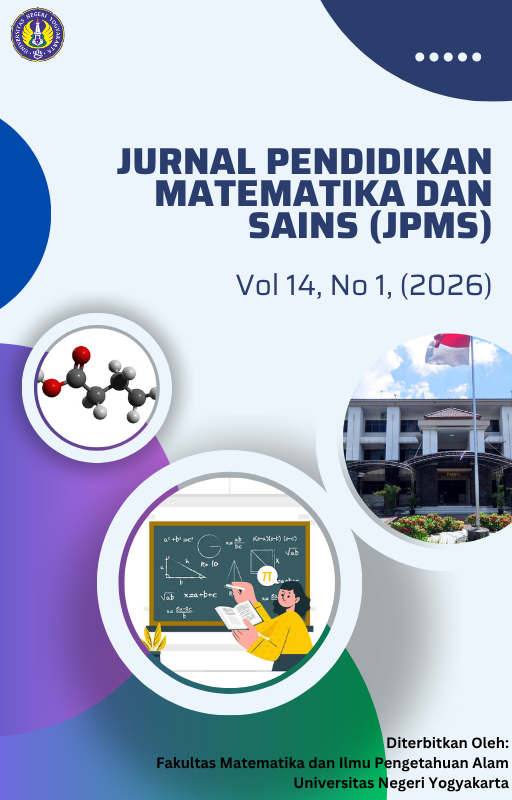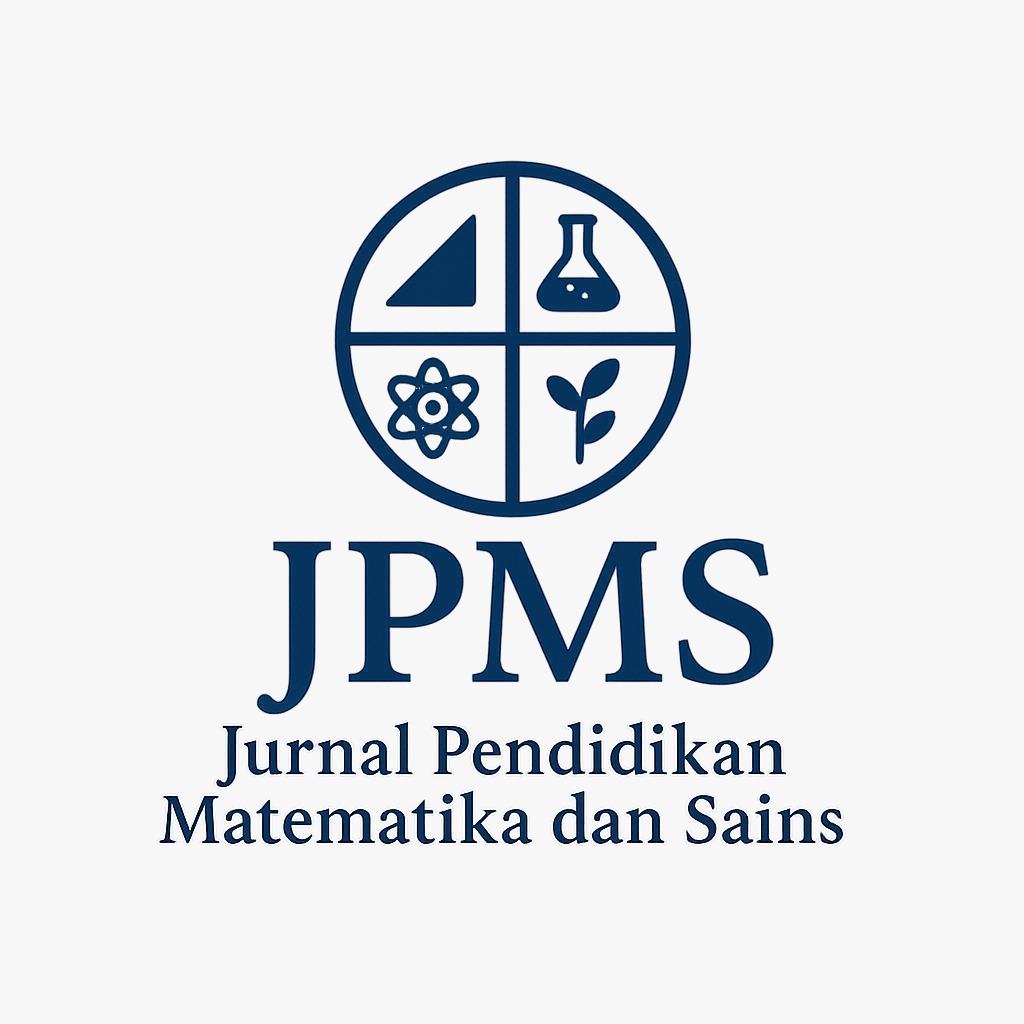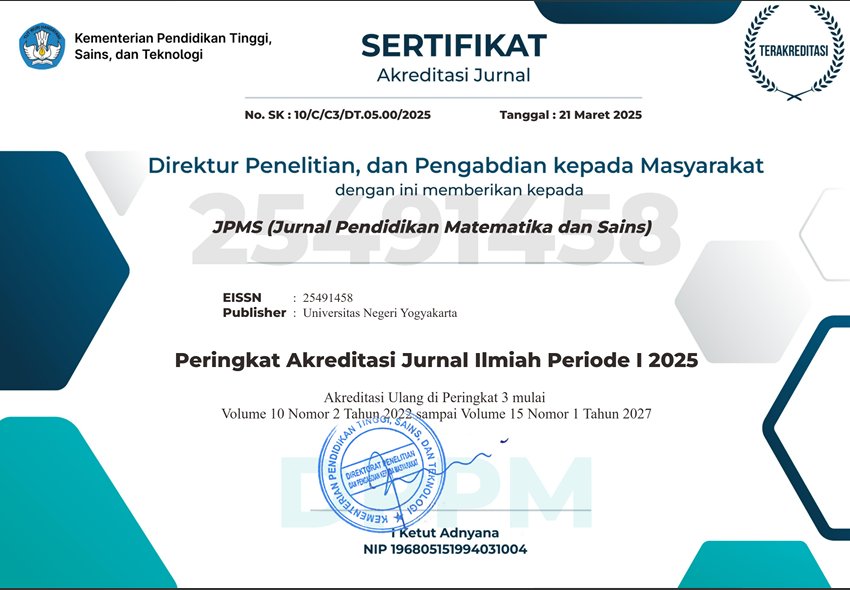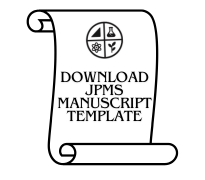Analisis Empiris Instrumen Pilihan Ganda Beralasan untuk Mengukur Pemahaman Konsep Mahasiswa pada Materi Getaran
DOI:
https://doi.org/10.21831/jpms.v14i1.90522Keywords:
Getaran, Instrumen pilihan ganda beralasan, Miskonsepsi, Pemahaman konsepAbstract
Penelitian ini bertujuan mengembangkan dan menguji instrumen pilihan ganda beralasan untuk mengukur pemahaman konsep mahasiswa prodi Pendidikan IPA pada materi getaran. Instrumen disusun berdasarkan peta konsep yang mengaitkan besaran fisis (periode, frekuensi, panjang, massa, amplitudo) dengan energi (potensial, kinetik, mekanik) serta penerapan GHS dalam konteks nyata. Terdapat 17 butir soal berlevel kognitif C2–C6 yang mengukur tiga aspek utama, yaitu hubungan antar besaran fisis, perubahan energi, dan penerapan konsep GHS. Hasil uji coba pada 117 mahasiswa menunjukkan bahwa sebagian besar soal tergolong sukar–sedang, memiliki daya pembeda 0,197–0,568, dan reliabilitas KR-20 sebesar 0,505 dalam kategori sedang. Analisis jawaban menunjukkan miskonsepsi terkait hubungan amplitudo, periode, dan energi, yang mengindikasikan kesulitan mahasiswa dalam mengaitkan konsep matematis dengan fenomena fisik. Secara keseluruhan, instrumen ini cukup diagnostik namun memerlukan revisi untuk meningkatkan konsistensi internal. Implikasi penelitian ini adalah memberikan dasar bagi pengembangan instrumen tes dalam identifikasi pemahaman konsep mahasiswa, sekaligus berkontribusi terhadap peningkatan kualitas asesmen dan pembelajaran di perguruan tinggi.
References
Brundage, M. J., & Singh, C. (2023). Development and validation of a conceptual multiple-choice survey instrument to assess student understanding of introductory thermodynamics. Physical Review Physics Education Research, 19(2), 020112. https://doi.org/10.1103/PhysRevPhysEducRes.19.020112
Cahyani, N., Auliah, A., Majid, A. F., & Kimia, J. (2024). Application of two-tier multiple choice assessment equipped with certainty of response index as a misconception diagnosis instrument in chemistry learning. Jurnal Pendidikan Matematika dan Sains, 12(1), 13–21. https://doi.org/10.21831/jpms.v12i1.74390
Didik, L. A., & Aulia, F. (2019). Analisa tingkat pemahaman dan miskonsepsi pada materi listrik statis mahasiswa tadris fisika menggunakan metode 3-tier multiple choices diagnostic. Phenomenon: Jurnal Pendidikan MIPA, 9(1), 99–111. https://doi.org/10.21580/phen.2019.9.1.2905
Fitriani, R., Maison, Asrial, Purwaningsih, S., & Asma, R. (2023). Diagnosing students’ conception of wave propagation using the five-tier isomorphic instrument. Jurnal Penelitian Pendidikan IPA, 9(11), 9461–9473. https://doi.org/10.29303/jppipa.v9i11.5413
Gurel, D. K., Eryilmaz, A., & McDermott, L. C. (2015). A review and comparison of diagnostic instruments to identify students’ misconceptions in science. Eurasia Journal of Mathematics, Science and Technology Education, 11(5), 989–1008. https://doi.org/10.12973/eurasia.2015.1369a
Hamdani. (2024). Diagnosa miskonsepsi siswa tentang getaran. Variabel, 7(1), 1–6. https://doi.org/10.26737/var.v7i1.4349
Juandi, T., Kaniawati, I., Samsudin, A., Riza, L. S., Susilawati, S., & Sapiruddin, S. (2024). Analysis of the validity and reliability of a critical thinking skills instrument on the topic of wave-particle duality using Rasch model. Quantum: Jurnal Inovasi Pendidikan Sains, 15(2), 197–209. https://doi.org/10.20527/quantum.v15i2.19996
Kahveci, A. (2013). Diagnostic assessment of student understanding of the particulate nature of matter: Decades of research. In Science Education Research and Practice in Europe (pp. 249–278). Springer. https://doi.org/10.1007/978-94-007-5914-5_12
Lengkong, M., Istiyono, E., Rampean, B. A. O., Mulia, A., Tumanggor, R., & Nirmala, T. (2021). Development of two-tier test instruments to detect students’ physics misconception. In Proceedings of the 7th International Conference on Research, Implementation, and Education of Mathematics and Sciences (ICRIEMS 2020) (pp. 561–566). Atlantis Press. https://doi.org/10.2991/assehr.k.210305.081
Lichtenberger, A., Hofer, S. I., Stern, E., & Vaterlaus, A. (2025). Enhanced conceptual understanding through formative assessment: Results of a randomized controlled intervention study in physics classes. Educational Assessment, Evaluation and Accountability, 37(1), 5–33. https://doi.org/10.1007/s11092-024-09440-4
Mahombar, A. (2024). Analisis pemahaman konsep dan kendala pemahaman konsep materi getaran dan gelombang. Jurnal Fisika dan Pembelajarannya (Phydagogic), 6(2).
Mardiyyaningsih, A. N., Erlina, E., Ulfah, M., & Wafiq, A. F. (2023). Validity and reliability of the two-tier diagnostic test to identify students’ alternative conceptions of intermolecular forces. Jurnal Penelitian Pendidikan IPA, 9(6), 4375–4381. https://doi.org/10.29303/jppipa.v9i6.2797
Mubarrak, M., Yusof, M., Syafika, A., & Arshad, B. (2022). Identifying students’ misconceptions of sound propagation. International Journal of Academic Research in Progressive Education and Development, 11(4), 39–51. https://doi.org/10.6007/IJARPED/v11-i4/15864
Mufit, F., & Karzah, K. (2024). Concept understanding and causes of student misconceptions on simple harmonic motion. JIPF (Jurnal Ilmu Pendidikan Fisika), 9(3), 464–473.
Pratama, F. I., Rohaeti, E., & Laksono, E. W. (2025). Building sustainable education with the literacy and research-oriented cooperative problem-based learning: A bridge in the activeness of chemistry education students. Jurnal Pendidikan Matematika Dan Sains, 13(Special_issue), 61–68. https://doi.org/10.21831/jpms.v13iSpecial_issue.8839
Pratidhina, E., Kuswanto, H., & Rosana, D. (2023). Developing physics-integrated computational thinking skills assessment instrument using Rasch measurement model. Jurnal Pendidikan Fisika dan Keilmuan (JPFK), 9(2), 161–171. https://doi.org/10.25273/jpfk.v9i2.20744
Putri, W. K., & Ermawati, F. U. (2021). Pengembangan, uji validitas dan reliabilitas tes diagnostik five-tier untuk materi getaran harmonis sederhana beserta hasil uji coba. PENDIPA Journal of Science Education, 5(1), 92–101. https://doi.org/10.33369/pendipa.5.1.92-101
Rambe, S. P., & Ulfa, S. W. (2022). Pemanfaatan multiple choice test beralasan terbuka dalam menganalisis miskonsepsi materi sistem pernapasan pada kelas XI sekolah menengah atas. Jurnal Pendidikan Biologi Indonesia, 8(2), 135–144.*
Resbiantoro, G., Setiani, R., & Dwikoranto. (2022). A review of misconception in physics: The diagnosis, causes, and remediation. Journal of Turkish Science Education, 19(2), 403–427. https://doi.org/10.36681/tused.2022.153
Samaduri, A. (2022). Analisis pemahaman konsep siswa yang diukur menggunakan tes pilihan ganda beralasan pada mata pelajaran biologi. Jurnal Pendidikan Glasser, 6(1), 109–118. https://doi.org/10.32529/glasser.v6i1.1466
Simatupang, D. S. (2024). Analisa getaran pada mesin pemisah limbah kayu dengan perbandingan putaran pada alat penekan berdasarkan time domain dengan menggunakan motor bensin [Undergraduate thesis, Universitas HKBP Nommensen]. https://repository.uhn.ac.id/handle/123456789/10893
Suyatman, S. (2023). Instrument validation of students’ analytical thinking skills in the natural science learning by using the Rasch model. JIPF (Jurnal Ilmu Pendidikan Fisika), 8(3), 269–277. https://doi.org/10.26737/jipf.v8i3.3555
Taber, K. S. (2018). The use of Cronbach’s alpha when developing and reporting research instruments in science education. Research in Science Education, 48(6), 1273–1296. https://doi.org/10.1007/s11165-016-9602-2
Tavakol, M., & Dennick, R. (2011). Making sense of Cronbach’s alpha. International Journal of Medical Education, 2, 53–55. https://doi.org/10.5116/ijme.4dfb.8dfd
Tavangar, A. (2024). Differential equations. eCampus Ontario. https://ecampusontario.pressbooks.pub/diffeq/
Titin, I., Sahala, S., & Pontianak, U. (2018). Remediasi miskonsepsi siswa pada materi getaran menggunakan model STAD berbantuan word square. Jurnal Pendidikan dan Pembelajaran Khatulistiwa (JPPK), 7(12). https://doi.org/10.26418/jppk.v7i12.30077
Tumanggor, A. M. R., Supahar, S., Ringo, E. S., & Harliadi, M. D. (2020). Detecting students’ misconception in simple harmonic motion concepts using four-tier diagnostic test instruments. Jurnal Ilmiah Pendidikan Fisika Al-Biruni, 9(1), 21–31. https://doi.org/10.24042/jipfalbiruni.v9i1.5125
Winarno, N., Mega, R., Afifah, A., Sihombing, R. A., Firdaus, R., & Damopolii, I. (2025). Analyzing misconceptions using four-tier test on the topic of vibration: A survey of pre-service science teachers. Unnes Science Education Journal, 13(1). https://doi.org/10.15294/usej.v13i1.20612
Downloads
Published
How to Cite
Issue
Section
Citation Check
License

This work is licensed under a Creative Commons Attribution-ShareAlike 4.0 International License.
Jurnal Pendidikan Matematika dan Sains allows readers to read, download, copy, distribute, print, search, or link to its articles' full texts and allows readers to use them for any other lawful purpose. The journal allows the author(s) to hold the copyright without restrictions. Finally, the journal allows the author(s) to retain publishing rights without restrictions
- Authors are allowed to archive their submitted article in an open access repository
- Authors are allowed to archive the final published article in an open access repository with an acknowledgment of its initial publication in this journal

This work is licensed under a Creative Commons Attribution-ShareAlike 4.0 Generic License.





